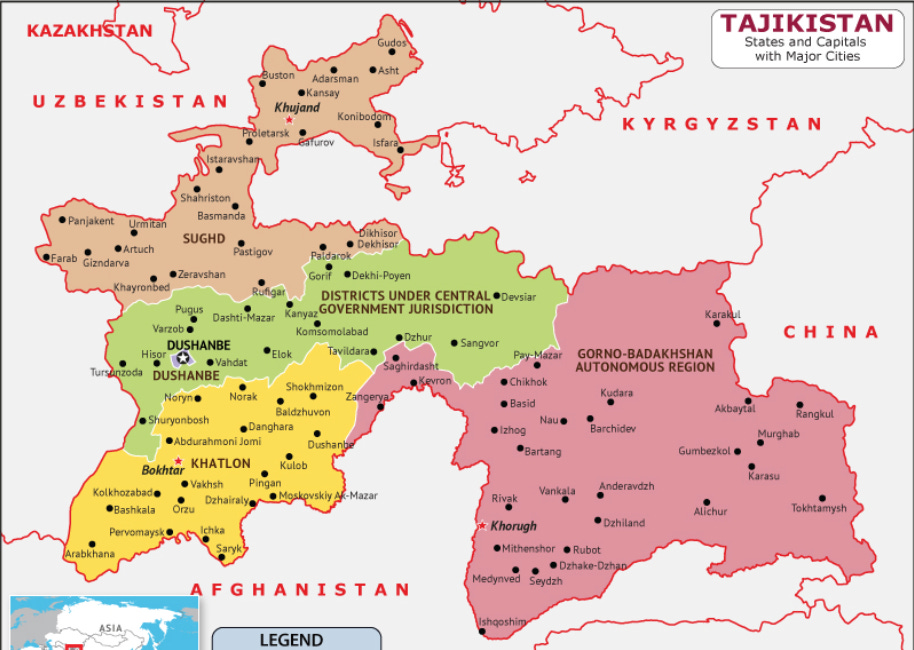23 November 2010
I began dating a European1 who worked in development and was stationed in Dushanbe. There was a limited dating pool for expats in the city, but in him I found some company for a brief fling. Though we weren’t a match on many fronts, which I tried to smooth over with alcohol (with the expected results), I did get a few stories out of it, like this one.
We decided to go to the northern city of Khujand for a weekend, where another aid organization had an office where a friend of his worked. Getting to Khujand from Dushanbe is not a simple thing. It ought to be like flying from Los Angeles to San Francisco, but like many things in this country, simple and logical frequently get lost along the way. In the winter, it gets more difficult, as the pass through the Fan Mountains can get snowed closed to cars, and the fog in the air grounds the planes. It’s not that far, by car, about 300 km, and flying takes about 40 minutes, our chosen means of travel.
The Charlie-Foxtrot that is Tajik Air's2 flight to Khujand began with standing in two wrong lines and sneaking into the VIP lounge for coffee before the flight. The VIP lounge is what any normal airport has: a café and snack bar with outrageous prices, but here it’s for the special people, not your average Tajik, lugging a child, a chicken, and a bag of sambusas aboard the flight.
The security farce that we all played along with involved showing your ticket to a guy guarding the door to the gate area, but first fighting your way past everyone else who somehow thought that getting through that door first would make the plane leave faster... followed by putting your bag through the X-ray machine, walking through the metal detector where the same guy who is supposed to be checking the screen to see how many flammable materials and contraband you put in your suitcase is busy checking your passport and ticket for a second time. Oh, and there’s no need to take off your shoes or coat.
The flight finally left an hour late, and I didn’t mind because whatever repairs, maintenance, or praying they needed to do to get this ancient prop plane with balding tires off the ground—please take all the time you need. I had never been on a plane that old. It was somehow hilarious to me, and I laughed again in terror as the plane slowly took off without the crew’s customary introduction and explanation of safety features. After all, there were no safety features. Having a flotation device under your seats on that plane would have been... extraneous? These planes are not up to international standards, so diplomats and other people who want to get reimbursed by their respective governments and companies only fly to Khujand when the newer Boeing is making the trip. Luckily, our return flight was on the Boeing.
We started our adventures going to the History and Local Lore Archeological Museum and Fortification, which Lonely Planet disparaged for being short on substance. It wasn’t so bad if you consider replications of great Persian antiquities as substance. What really made it great was our friendly Tajik tour guide who gave a wonderful, if fractured, and rehearsed tour in English (all the plaques are in Tajiki).
What was interesting was the lack of information. The museum endeavored to show the history of Khujand from the days of yore, through Alexander the Great’s invasion—the museum proudly houses the only—or was it largest?—mosaic made with local stones and gems in Central Asia depicting the life of Alexander the Great in 16 panels. One panel was dedicated solely to Alexander’s marriage to a Tajik girl named Roxanna.
The displays leading to the present were trying very hard to show the continuity in the Persianate identity, though our tour guide called everything Tajik. As in, “Ferdowsi was the great Tajik poet who wrote the Shahnameh, and here is an old edition.” I know some Iranians who would beg to differ. By the time we got to the modern era, the highlights were on President Rahmon. Photos of him inaugurating the museum with Iran’s President Ahmadinejad, photos of him with Ahmadinejad inaugurating the (notoriously shoddy and unventilated) tunnel that the Iranians built, and the like. The complete lack of information, not even a slight mention by the tour guide of the museum of history, of the not too-recently ended civil war which gripped the country from 1992-1997—one that killed almost 100,000 people, and displaced over 1 million (out of a population of 7 million)—was striking, to say the least. I guess they’re trying to move on.
After the museum, we went to lunch at a shi-shi café on the same square as the museum, where I was flummoxed first by the Russian-only menu and then by the huge wall photo/poster of the Twin Towers on the wall behind me. What in God’s green earth was the point of that? They speak a lot more Russian in Khujand than in Dushanbe—which is not surprising considering the proximity to the motherland, uh, I mean to Russia. Later, in the bazaar, I tried to show off my Tajiki and buy bananas from a man who refused to speak Tajiki with me and kept answering in Russian. I was annoyed, though I did learn that there is a word in Russian for the number 1.5 (полтора/[poltara]) because bananas are usually 1.5 Somoni EACH, which is expensive compared to other fruits here.
We toured the local office of the NGO where our friends worked and then headed to the Pink Palace, actually called the Arbob Palace. To quote Wikipedia:
“The Arbob Cultural Palace is the former headquarters of a soviet collective farm, built in the 1950s and modelled on the winter gardens of Peterhof, St Petersburg. The main building consists of three wings - with an ornate theatre seating 800 people in the main wing. The South wing currently houses a museum which tells the history of Arbob and of collectivisation and the soviet empire in Tajikistan. Outside the building is a procession of fountains and rose gardens running to the arrival driveway and a bust of Lenin. The centre was built in the 1950s under the leadership of Urukhojaev, the head of the collective farm. Urukhojaev was a significant Tajik who sat on Soviet committees and was well known.”
This was the quote from the Wikipedia entry in 2010 when I first wrote this post. Now, fourteen years later, there is an emphasis on Tajikistan’s independence and President Rahmon’s peaceful legacy:
The building had particular significance in 1992, when it was the site for the meeting of the Tajik Soviet which officially declared independence from the Soviet Union. It was the site where the Tajik flag was chosen.
More recently, in the late 1990s, it was also the site where peace conferences following the Tajik civil war were held. In particular, Tajik President Emomalii Rahmon first came to prominence speaking at the Palace, and it was the site for a "plov of peace" which celebrated successful negotiations towards an agreed end to the Tajik civil war.3
The man who built the palace, Urukhojaev, was not only significant politically, he was a huge and imposing man who sadly died early of stomach cancer. From all the photos in the museum/palace of him schmoozing with peasants, collective farmers, and Soviet big-wigs, he seemed a bit like a Tajik Rasputin. He clearly embodied the hard-working, land and food-loving nature of the Tajik people.
Another fascinating aspect of the palace was that it was a prime location for Tajik wedding photo shoots, and as it was Saturday when most weddings are held, there was an invasion of brides, grooms, their entourages, and the cameraman. The brides would pose in front of their flower-bedecked cars with a serious look on their faces. Then they would get in the car and the cars would be filmed driving slowly in front of the palace. We were asked to move several times so as not to ruin the shot. I counted at least 13 brides, all in their poofy white gowns with ornate beading on the bodices. Even when they get married, there’s a sort of uniformness to the apparel.
That was one day. After pasta, wine, beer, vodka, and some good bowling, the day was finally over around 1 am.
The end.
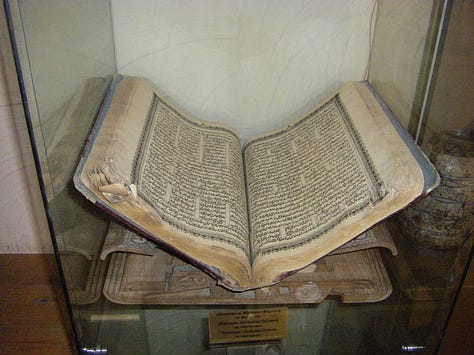
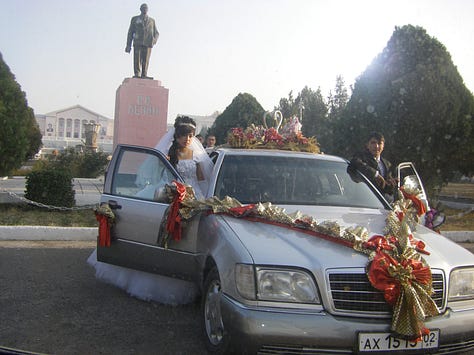
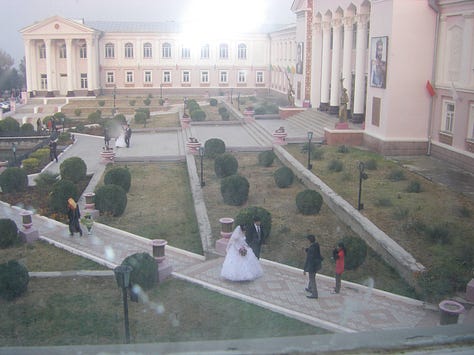

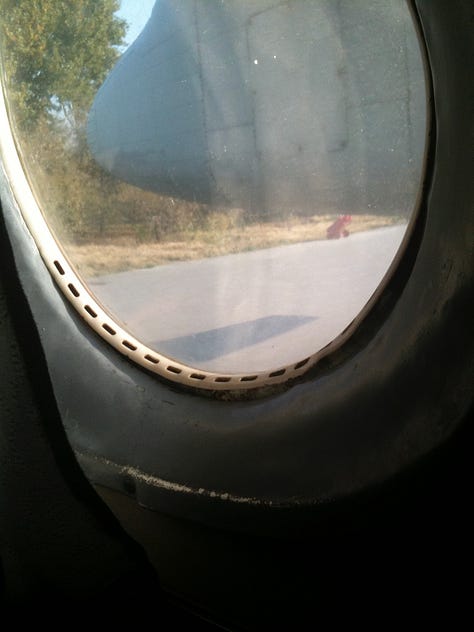

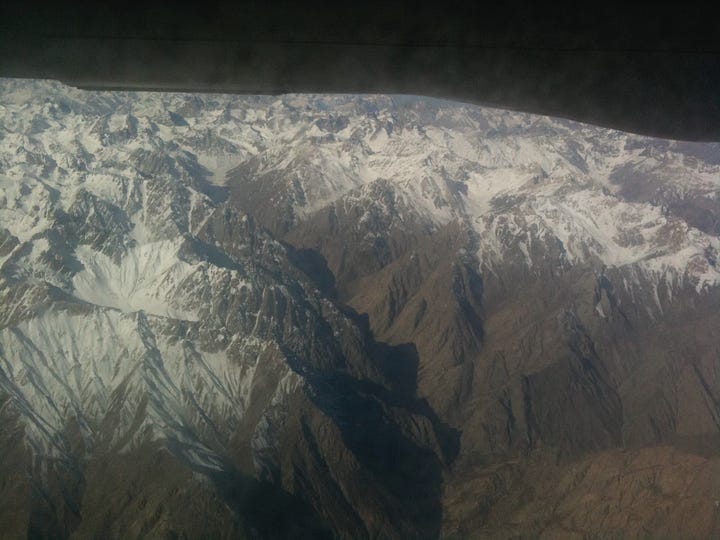
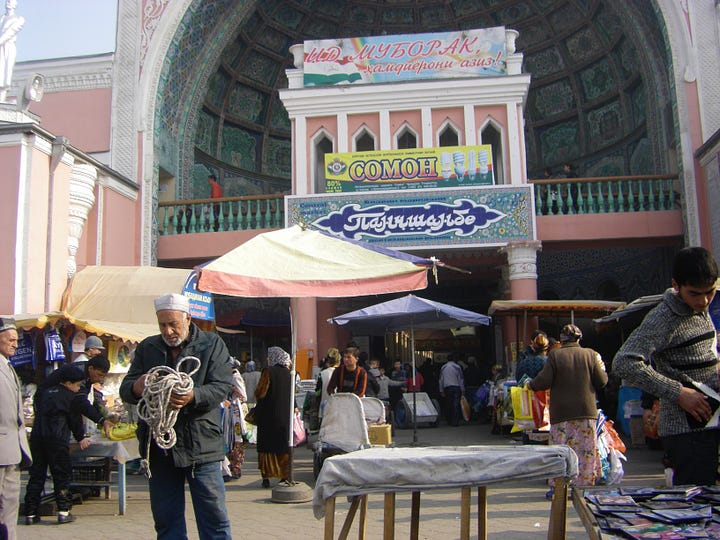
Want to read more posts from my blog series about my time in Tajikistan? Here’s the prior one, and the first one: Be my guest! Befarmayid!
Tajik Sweet Sixteen #15
I remember being sixteen on the feelings level. The pimples, the insecurity, the unknownness of life. It’s not as if it were yesterday, but hanging out with teenagers, it all comes back. Here’s a story about a girl’s life in Dushanbe.
Tajikistan Travel Blog Throwback #1
This series will be an edited reposting of a blog I sent out into the Digi-verse in 2010-2011 when I studied Persian in Tajikistan as part of my Master's degree in that language. Iran and Afghanistan being off limits to Americans then as now, the closest us students of Persian-Farsi could get was to Tajikistan, the Central Asian country of 7 million, which at least borders on Afghanistan. They speak a dialect of Persian that uses the Cyrillic alphabet and is heavily influenced by Russian and Uzbek. The first word I learned in my host family was ‘piola’ for some cup or bowl, which I couldn’t find in any Persian dictionary because it was apparently Russian or Uzbek. This happened for nine months. Tajikistan was once part of the Soviet Union and remained the poorest former state. Its history, culturally, economically, and politically, is impossible to understand without knowing this. I didn’t appreciate that fact when I first arrived.
Usually code for “Italian” in my life
Tajik Air has since “suspended operations” in 2019.
https://en.wikipedia.org/wiki/Arbob_Cultural_Palace,_Khujand





